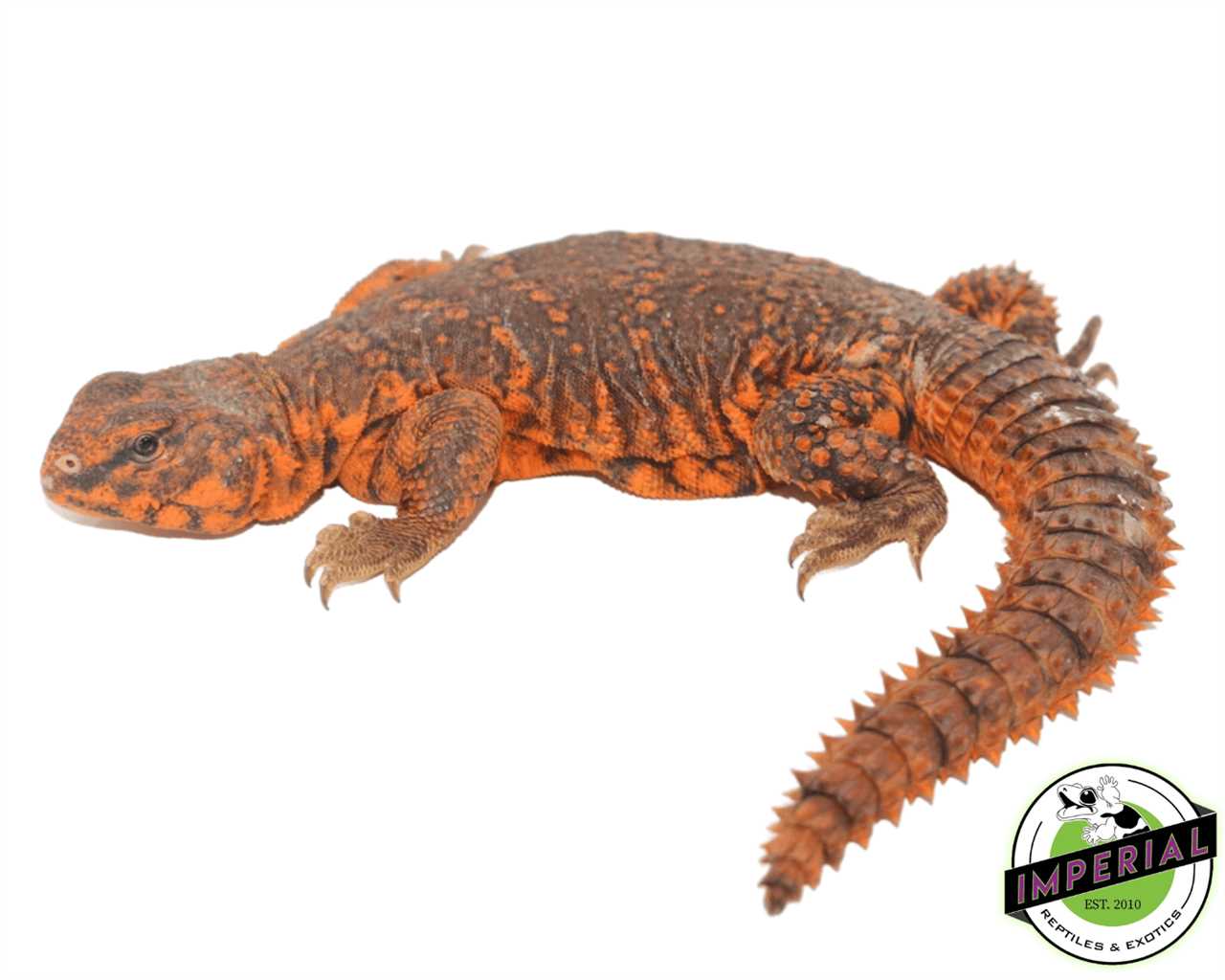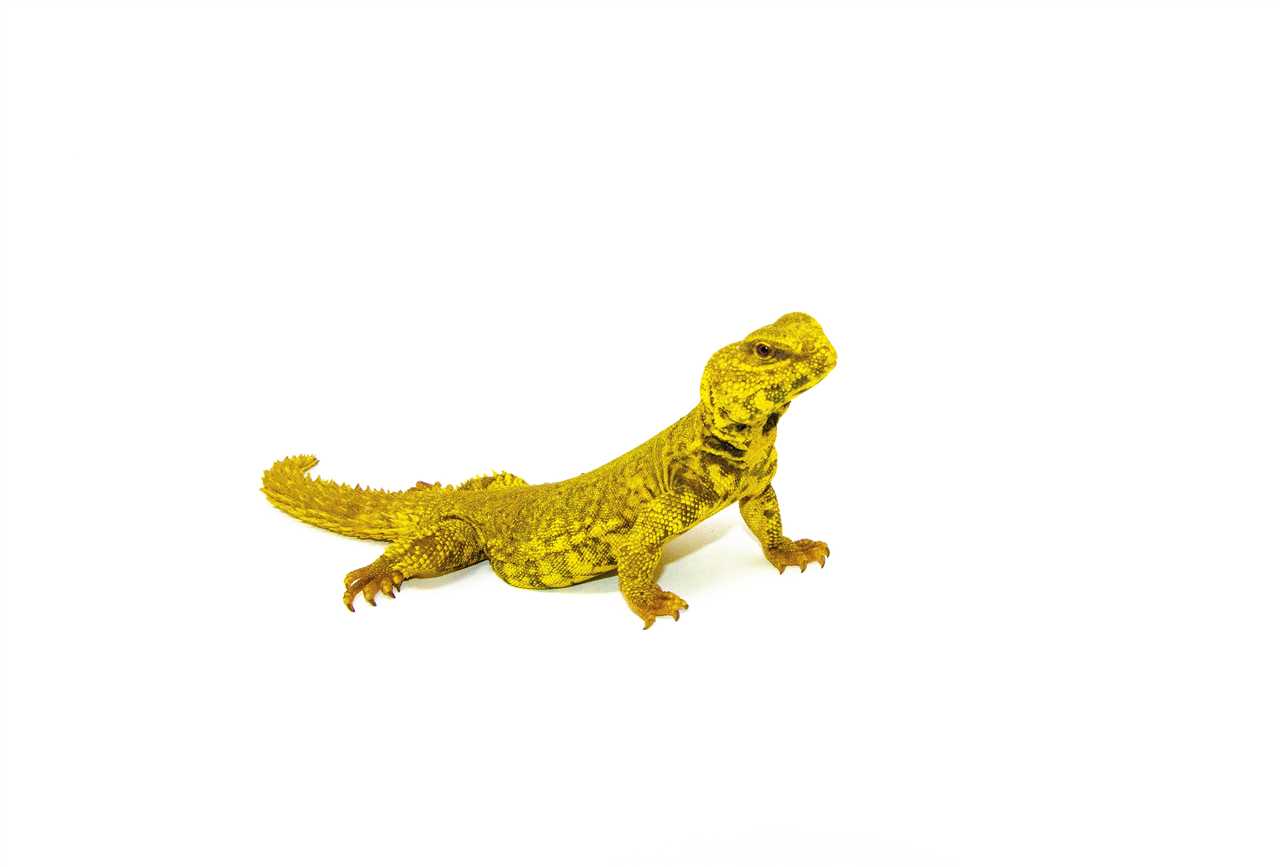
So, if you are ready to add a splash of color to your reptile collection, the Yellow Nigerian Uromastyx is a fantastic choice. With their vibrant yellow scales and unique personality, they are sure to become the center of attention in your home. Just remember to provide them with a suitable environment, a nutritious diet, and regular care to ensure their longevity and happiness.
What is a Yellow Nigerian Uromastyx?
Appearance

The Yellow Nigerian Uromastyx is easily recognizable by its vibrant yellow coloration, which extends to its body, tail, and limbs. It has a stout body with a broad head and a short, thick tail. The scales on its back and sides are large and bumpy, giving it a spiky appearance. This reptile can grow up to 35 centimeters in length, with males typically being larger than females.
Characteristics
| Common Name | Yellow Nigerian Uromastyx |
|---|---|
| Scientific Name | Uromastyx spp. |
| Family | Agamidae |
| Native Region | Nigeria |
Temperament
The Yellow Nigerian Uromastyx is generally docile and can make a great pet for reptile enthusiasts. However, it may exhibit defensive behaviors, such as puffing up its body and tail to appear larger, if it feels threatened. With proper handling and socialization, these reptiles can become relatively tame and comfortable being handled by their owners.
| Tendency | Docile |
|---|---|
| Defensive Behaviors | Puffing Up Body and Tail |
| Handling | Requires Proper Socialization |
Characteristics of the Yellow Nigerian Uromastyx
One of the most distinctive characteristics of the Yellow Nigerian Uromastyx is its size. Adult males can reach a length of up to 18 inches, while females are slightly smaller, typically reaching lengths of around 12 to 15 inches. Despite their size, these reptiles are relatively lightweight, with males weighing around 1 to 2 pounds and females weighing slightly less.
In addition to their size, the Yellow Nigerian Uromastyx also has unique physical features that set it apart from other reptiles. Its body is covered in thick, bumpy scales that provide protection from predators and help to retain moisture. These scales also give the reptile a rough and textured appearance.
Another interesting feature of the Yellow Nigerian Uromastyx is their ability to regulate their body temperature. Like other reptiles, they are ectothermic, which means that they rely on the environment to regulate their body heat. This is why it is crucial to maintain the proper temperature and lighting conditions in their enclosure.
Overall, the Yellow Nigerian Uromastyx is a fascinating reptile with unique characteristics. Its striking yellow coloration, distinctive size, and textured scales make it a captivating pet for reptile enthusiasts. Proper care and attention to its specific habitat requirements are essential to ensure its health and well-being.
Appearance of Yellow Nigerian Uromastyx
Yellow Nigerian Uromastyx is a unique reptile that is known for its distinctive appearance. It is a lizard species that belongs to the Uromastyx genus, native to the arid regions of Africa. The name “nigerian” refers to its origin from Nigeria, where it is commonly found.
Physical Characteristics
The Yellow Nigerian Uromastyx is a medium-sized lizard with an average length of 14 to 18 inches. It has a stocky body with a flat tail and a spiny appearance. The coloration of this reptile is mainly yellow, with some individuals displaying shades of orange and brown. Their scales have a rough texture, providing protection from the harsh desert environment.
One of the most striking features of the Yellow Nigerian Uromastyx is its prominent spines. These spines are located along its back and tail, and they serve as a means of defense against predators. When threatened, the Uromastyx can erect these spines, making it appear larger and more intimidating.
Head and Face
The head of the Yellow Nigerian Uromastyx is relatively large in proportion to its body. It has a blunt snout and a strong jaw, equipped with sharp teeth for crushing tough vegetation. The eyes are located on the sides of the head, providing a wide field of vision to detect potential predators.
On top of its head, the Uromastyx has a row of spines running from the back of its head to the tip of its nose. These spines add to its unique appearance and offer protection against attacks from above.
Coloration
The Yellow Nigerian Uromastyx gets its name from its vibrant yellow coloration. However, the intensity of the yellow can vary between individuals, with some displaying a lighter shade while others have a deeper, more golden color. Along with the yellow hue, some Uromastyx specimens may have patches or stripes of orange or brown on their bodies.
Temperament
The Yellow Nigerian Uromastyx is known for its docile and gentle nature, making it a popular choice among reptile enthusiasts. Unlike some other reptiles, this species is not aggressive and can be easily handled with proper care and training.
It is essential to provide a comfortable and secure habitat for the Yellow Nigerian Uromastyx to thrive. This includes offering appropriate hiding spots and furnishings, as well as maintaining a consistent temperature and lighting setup. A well-cared-for uromastyx will typically exhibit a calm and content demeanor.
Remember, uromastyx are still reptiles, and while they may be relatively tame, they can still bite if they feel threatened or cornered. Always be cautious and approach them with care, especially during feeding, cleaning, or any other activities that may cause them stress.
Caring for Your Yellow Nigerian Uromastyx: Setting Up the Perfect Enclosure
The Enclosure: The enclosure for your Yellow Nigerian Uromastyx should be spacious enough to allow them to move around comfortably. A tank or terrarium that is at least 40 gallons in size is recommended. Make sure the enclosure has a secure lid to prevent escape.
Temperature and Lighting: Yellow Nigerian Uromastyx require a temperature gradient in their enclosure. Provide a basking spot with a temperature of around 100°F (37°C) and a cooler area around 80°F (27°C). UVB lighting is essential for their overall health, as it helps with calcium absorption. Use a reptile-specific UVB bulb and ensure it is replaced every 6 to 12 months.
Monitoring and Maintenance: Regularly monitor the temperature and humidity levels in the enclosure to ensure they are within the appropriate range. Clean the enclosure and remove any waste or uneaten food to maintain a clean and hygienic environment. Regularly check for signs of illness or injury and consult a reptile veterinarian if needed.
The Perfect Enclosure for Your Yellow Nigerian Uromastyx
Creating the perfect enclosure for your Yellow Nigerian Uromastyx is essential to ensure its well-being and overall health. These reptiles require specific conditions to thrive and feel comfortable in their environment.
Cage Requirements
When choosing a cage for your Yellow Nigerian Uromastyx, it’s crucial to prioritize size and security. The enclosure should be spacious enough to allow the reptile to move around freely and exhibit its natural behaviors. A tank with dimensions of at least 4 feet long, 2 feet wide, and 2 feet high is recommended for a single adult Uromastyx.
The walls of the cage should be made of sturdy materials like glass or plastic, ensuring that it can’t be easily broken or climbed. Additionally, it’s essential to provide a secure lid or mesh top to prevent the Uromastyx from escaping.
Temperature and Lighting
Yellow Nigerian Uromastyx requires a temperature gradient within their enclosure to regulate their body temperature effectively. Provide a basking spot with a temperature of around 110°F (43°C) at one end of the enclosure. The cool side of the cage should be kept around 80°F (27°C). This temperature gradient allows your Uromastyx to thermoregulate by moving between the warm and cool areas.
Proper lighting is also crucial for the overall health of your Yellow Nigerian Uromastyx. Use full-spectrum UVB fluorescent lighting to provide the necessary UVB rays, which are essential for their calcium metabolism and vitamin D synthesis. Ensure the UVB lights are replaced regularly according to the manufacturer’s instructions to maintain their effectiveness.
Creating the perfect enclosure that meets the specific needs of a Yellow Nigerian Uromastyx is crucial for their overall well-being. By providing a spacious and secure enclosure with the proper temperature and lighting, you will ensure that your Uromastyx remains happy and healthy for years to come.
Temperature and Lighting
One of the most important aspects of caring for a Yellow Nigerian Uromastyx is providing the proper temperature and lighting in their enclosure. These reptiles are ectothermic, meaning they rely on external heat sources to regulate their body temperature. It is crucial to create a temperature gradient in the enclosure to allow the Uromastyx to choose the temperature that best suits its needs.
Temperature: The ideal temperature range for a Yellow Nigerian Uromastyx is between 95-110°F (35-43°C) during the day. This can be achieved by using a combination of heat lamps, ceramic heat emitters, and under-tank heating pads. It is essential to monitor the temperature regularly with a reliable thermometer to ensure it stays within the recommended range.
Note: The Uromastyx must have a cooler area in the enclosure, usually in the range of 80-85°F (27-29°C), to retreat to if it becomes too hot. This temperature should be provided on one side of the enclosure, while the warmer area should be on the other side.
Lighting: In addition to the heat source, proper lighting is also crucial for the overall health and well-being of a Yellow Nigerian Uromastyx. These reptiles require UVB lighting to synthesize vitamin D3, which is important for calcium absorption and bone health. You will need to provide a UVB bulb specifically designed for reptiles, along with a regular incandescent bulb for heat.
Remember to regularly monitor the temperature and lighting conditions in the enclosure to ensure they remain within the optimal range for the Yellow Nigerian Uromastyx’s health and comfort.

I’m Lena Adams—a product of an unconventional upbringing in the African wilderness. My father, a daring explorer of African wildlife, sparked my fascination with reptiles, a passion that intertwined with the tragic loss of my mother during an expedition, leaving an indelible mark on my life. Driven to understand the creatures that captivated my parents, I embarked on my journey, sharing insights about reptiles, frogs, and lizards on my website. Through my explorations and conservation efforts, I honour my family’s legacy while seeking connections—to the creatures, nature, and the mother whose presence I yearn to understand.
